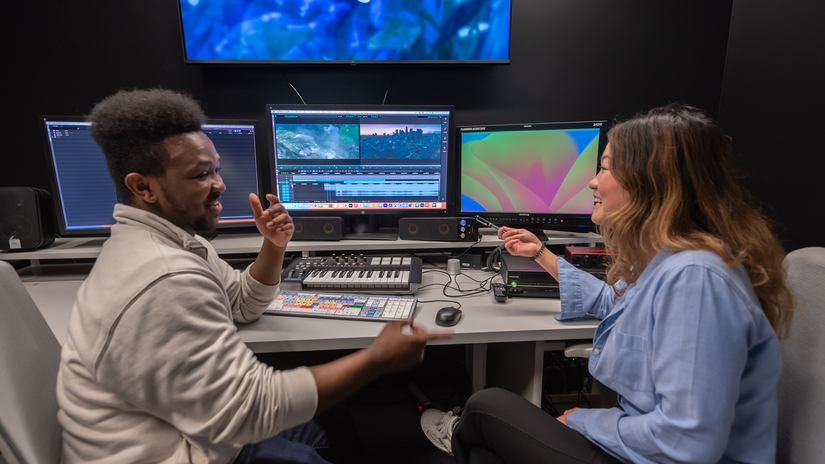FILM 5 | Film and Society3 unitsTransfer: UC, CSU Formerly CINEMA 5. This course presents motion pictures as reflections and influences of American society. Films are often selected from specific decades and analyzed as records of social attitudes shaping the present and past. |
|---|---|
FILM 50 | Production Sound3 unitsTransfer: CSU This course provides a practical in-depth study of the fundamental aspects of recording and mixing production sound for film and television. Subjects include: introduction to production sound equipment, location sound recording and mixing techniques, on-set sound assessment and troubleshooting, digital audio workstation basics, along with dialogue and ADR (automated dialogue replacement) recording and editing. |
FILM 6 | Women in Film3 unitsTransfer: UC, CSU Formerly CINEMA 8. This course is a historical study and survey of the multiple and varied images of women in film. Students will screen and analyze films over seven decades, beginning with the 1930s. Students will also read, discuss, and write about women’s roles in these films. The focus is to analyze the representation of women in each film screened, to discuss how character roles have changed over time, and to examine occupation, dress, and rules of behavior. |
FILM 7 | American Cinema: Crossing Cultures3 unitsTransfer: UC, CSU Satisfies Global Citizenship Formerly CINEMA 7. This course surveys American motion pictures that have been made by filmmakers representing three United States ethnic groups, including African Americans, Latino Americans, and Asian Americans. Students will also analyze Hollywood’s treatment of those ethnic cultures throughout film history. |
FILM 8 | The Popular Film Genres3 unitsTransfer: UC, CSU Formerly CINEMA 2. This introductory course surveys the development and artistic, social, and entertainment ingredients of basic film genres. Emphasis on such types as the science-fiction film, western, gangster film, crime and detective thriller (“film noir”), musical, comedy, or horror film. |
FILM 88A | Independent Studies in Film1 unitTransfer: CSU Please see “Independent Studies” section. |
FILM 88B | Independent Studies in Film2 unitsTransfer: CSU Please see “Independent Studies” section. |
FILM 88C | Independent Studies in Film3 unitsTransfer: CSU Please see “Independent Studies” section. |
FILM 9 | The Great Film Makers3 unitsTransfer: UC, CSU
Formerly CINEMA 4. This course covers a limited number of film directors, writers, producers, and/or actors, examining their work in artistic, social, and historical terms. The course content and emphasis changes each term. |
FILM 90A | Film Internship1 unitTransfer: CSU Please see “Internships” section. |
FILM 90B | Film Internship2 unitsTransfer: CSU Please see “Internships” section. |
FRENCH 1 | Elementary French I5 unitsTransfer: UC, CSU Satisfies Global Citizenship This course introduces the students to basic vocabulary and fundamental sentence structures in the present and past. Pronunciation, grammar and everyday vocabulary are stressed as indispensable tools for comprehension and expression. French customs, culture and everyday life are also highlighted. The course is taught in French except in cases of linguistic difficulty as determined by the professor. |
FRENCH 2 | Elementary French II5 unitsTransfer: UC, CSU Satisfies Global Citizenship
This course completes the basics of the language further stressing pronunciation, grammar and everyday vocabulary as indispensable tools for comprehension. It also includes simplified readings highlighting French customs, culture, and everyday life. This course is taught in French except in cases of linguistic difficulty as determined by the professor. *The advisory for this course is comparable to two years of high school French. |
FRENCH 20 | Francophone Cultures through Films3 unitsTransfer: UC, CSU Satisfies Global Citizenship
The course examines the different cultures of the French-speaking world through the analysis of films. Students will not only learn some vocabulary pertinent to the analysis of films but they will also practice advanced conversation and study advanced grammar through written and spoken tasks. The films chosen for the course focus on the important issues that characterize the French-speaking world such as colonialism, diversity, immigration, and women’s issues, among others. This course will be taught in French except in cases of linguistic difficulty as determined by the professor. |
FRENCH 3 | Intermediate French I5 unitsTransfer: UC, CSU Satisfies Global Citizenship
This course reviews French grammar emphasizing idiomatic construction and expressions. Discussions are based on selected readings from contemporary French literature. The course is taught in French except in cases of linguistic difficulty as determined by the professor. *The advisory for this course is comparable to three years of high school French. |
FRENCH 31A | Practical French3 unitsTransfer: CSU This course is designed to develop effective communication skills. It emphasizes the use of set-up phrases, idiomatic expressions, correct pronunciation and intonation, development of useful vocabulary, and ability to communicate without hesitation in a given situation. This course does not fulfill the language requirement. This course is taught in French unless in cases of linguistic difficulty as determined by the professor. |
FRENCH 4 | Intermediate French II5 unitsTransfer: UC, CSU Satisfies Global Citizenship
This course continues the review of functional French grammar with emphasis upon idiomatic constructions and expressions. Discussions are based on selected readings from contemporary French literature. This course is taught in French except in cases of linguistic difficulty as determined by the professor. *The advisory for this course is comparable to four years of high school French. |
FRENCH 8 | Conversational French2 unitsTransfer: UC, CSU
*The prerequisite for this course is comparable to three years of high school French. This course provides an opportunity to acquire fluency in spoken French with emphasis on natural, colloquial use. This course is taught in French unless in cases of linguistic difficulty as determined by the professor. |
FRENCH 88A | Independent Studies in French1 unitTransfer: CSU Please see “Independent Studies” section. |
FRENCH 88C | Independent Studies in French3 unitsTransfer: CSU Please see “Independent Studies” section. |




